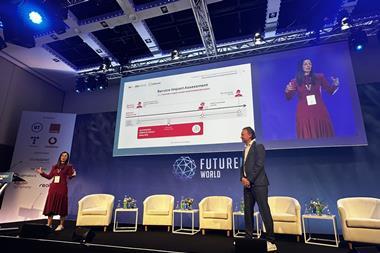- Evolving at breakneck speed, the Linux Foundation Europe Project Sylva is highlighting opportunities for the open-source cloud‑native platform to unlock solutions development as well as greater efficiency for the telco cloud.
- Telco SI Celfocus pinpoints streamlined mobile private network propositions that can be developed and scaled to advance operators beyond connectivity into delivery of connected enterprise experiences.
- Automation is considered key to developing a true killer app, with AIOps central to enabling the goal of an ‘MPN in a box’.
- Backed by Europe’s leading telcos and major vendors, Project Sylva can be a game‑changer for new operator business models, and Celfocus is urging the industry to move quickly to fully appreciate the framework’s potential.

Telecoms systems integrator Celfocus is playing a key role in the evolution and adoption of Project Sylva, an open-source cloud‑native framework for telco that is enabling new use cases and increasing efficiency across telco cloud and edge.
The Sylva initiative draws on skills and expertise from multiple tier-one operators (such as active participants DT, Orange, Telefónica, and TIM) and other key players in the communications ecosystem (including Ericsson, Nokia, and SUSE). This innovation is a notable part of a wider industry shift beyond traditional, more guarded, telco collaboration, according to Andre Vieira, the communication and adoption working group leader of Project Sylva who also leads the Operation Intelligence offer and architecture at Celfocus.
“ One of the main breakthroughs of the Sylva project is the level of sharing that we’ve seen on the operators’ networks. Four years ago, what we’re seeing today was impossible. The way operators like Orange and Telefónica and Deutsche Telekom are exchanging ideas here is a very Silicon Valley way of doing things, and it’s making things happen fast. ”
Vieira.
Celfocus sees the significance of collaborative initiatives such as Sylva from the perspective of a consultative partner and telco SI — what Vieira cheerfully describes as acting as “an operator’s true partner with a common goal”.
From this viewpoint, he sees Sylva not only supporting an accelerated evolution of the foundations for next-generation architecture, but also unlocking the long‑sought ability to develop services and solutions that can be developed cost‑effectively and are also scalable.

This can open the potential for operators to play to their existing strengths in both sales and technology, as they target the opportunity to more effectively monetise services for the small‑ and medium‑size enterprise (SME) market.
Enthusiasm for Project Sylva is growing across the industry, with Philippe Ensarguet, Vice‑President of Software Engineering at Orange, recently describing the open source nature of the platform as “game‑changing” as his company commits heavily to its potential for operational and commercial transformation of its network and the creation of “a new horizontal model for telcos”.
Celfocus itself is working with the community to crystallise the potential through a Sylva proof of concept pilot centred on creation of 5G mobile private networks (MPN) that shows a way forward in making MPNs a simpler, scalable proposition.
Through a use case that automates network slicing to ensure sufficient resources for critical use cases, along with location services and potential for value‑added apps and services to be loaded, Celfocus is promising a breakthrough for operators on two fronts:
1. Delivering commercial MPN offerings that can be sold effectively in the SME space.
2. Putting telco connectivity capabilities at the heart of the next generation of in‑demand services.
As the POC moves towards development of a minimum viable product, Vieira is envisaging an operator launch on the horizon. As this opportunity to cost‑effectively monetise 5G and MPN technology approaches, Celfocus is optimistic that after a sustained period of drought, telcos may once again find a way to develop the next wave of ‘killer apps’.
Telco cloud’s Sylva lining

Project Sylva was instigated by leading European operators, Deutsche Telekom, Orange, Telefónica, TIM, and Vodafone, working alongside major network equipment and IT specialists — including Ericsson, Nokia, Red Hat and SUSE — with the aim of creating a “telco-friendly” cloud software framework, a reference implementation, and a validation programme for ongoing deployment.
The project is intended to provide an architecture that can manage emerging network use cases from the core to the edge, including distributed user plane functions, open RAN, and content delivery networks.
The Sylva environment is also intended for applications beyond telco’s own operations, with its ability to support workloads that may be latency- or bandwidth-sensitive, opening up potential for its deployment in demanding industries such as smart manufacturing and aerospace.
Orange is arguably the leading proponent of Sylva, which is placed at the heart of its modernised horizontal cloud-native telco environment, with the operator working to harden, secure, and configure the framework as the basis of its telco cloud infrastructure.
Project Sylva was formally recognised as an open source project in November 2022, securing Linux Foundation backing, and by February 2024 had reached the milestone of its first general release.

Celfocus’s Andre Vieira has consulted on and helped implement transformation projects supporting the virtualisation and softwarisation of telecoms architecture for more than a decade. He will be appearing at the Network X event in Paris on 8 October 2024, representing Sylva on the Building Cloud-Native for Telco with Open Source panel that includes Telefónica.
Connected experiences on the horizon, with simplicity key to the killer app
“Right now, applying current mobile private network solutions in the SME sector is like trying to kill a fly with a bazooka”, says Vieira: “there’s no proportionate technology available”.
The answer, he believes, is not to build a mini‑version of existing options, but to approach the challenge with a focus on creating a technology that can adjust effectively for both small and large business needs. “We are not focused on doing something that’s just cheaper”, he says: “we’re focused on scalable flexibility”.
“ If we can help productise the MPN for SMEs, we can meet telco executives’ demand for solutions that reflect both the experience of commercial sales teams and enable the operators to expand their markets. ”
Vieira.
This re‑emergence of connectivity as key to a killer app will come in the more sophisticated guise of connected experiences rather than pure connectivity, according to Joao Antunes, Head of Autonomous Networks at Celfocus.

Drawing on the recent Sylva proof of concept, Antunes paints a picture of a typical healthcare facility that has long corridors, thick walls, and basements (and sub‑basements), proving a daunting challenge to leveraging public networks for critical connectivity and communications across a site. This is also an environment where network security is vital. An effective MPN would enable workers to pinpoint any equipment or person across the site, and enable new services such as autonomous guided vehicles delivering medication or sanitised equipment.
“ We don’t want medical staff running around across basements or equipment rooms trying to find medicines or vital equipment. We want them taking care of people. That’s why we think reliable, secure communications, with location abilities with 30cm precision, can be the killer app. ”
Antunes.
It will be important for the new connected experience offerings to be as simple to understand — and to sell — as traditional SIM‑based connections, believes Vieira. Operators’ commercial teams will need to understand MPNs and how they can benefit their customers’ businesses, with the simplicity of any solution developed core to achieving this.
“ CSPs need to shift their mentality to grow in the enterprise market, but we also need to ensure the product is at a level that is very simple to understand, very simple to deploy, very simple to sell. ”
Antunes.
While development of the solution is still at a relatively early stage, Celfocus anticipates that a disruptive shift in MPN go-to-market for the SME sector can be achieved by defining the main pillars and developing the foundations with the Sylva stack.
“ Who knows!? It could become something that you could pick up from a store, build your own MPN: drop in one or two devices; click the button; and just start up your own network for your business. That’s the kind of the mentality that we want to encourage here. ”
Antunes.
Cutting through the complexity demands AIOps for automation
AIOps can be a key enabler in delivering the levels of automation necessary to streamline network-based solutions, and this has been one of Celfocus’s principal contributions to the development of Sylva.
“As a technology stack, what we want to support and we are beginning to support is the introduction of AIOps”, explains Vieira, “We have the stack; we have the standards; now we need to monitor it”.
This AIOps‑enablement is crucial for Vieira because, “first you need to manage your network before you can sell the capabilities of your network as a function or an app”.
Services will not scale if operators cannot automate as much as possible, adds Antunes. “It needs to be a network that runs by itself, that heals itself, and is even self‑serviceable”, he says, “There needs to be a portal where an MPN customer can request more SIM cards, more Office 365 connections, more network space, cloud storage. And all of this needs to be self‑service or it will not scale for what we want to do”.
Antunes sees Celfocus’s experience in bringing AI automation to network monitoring, as well as delivering end‑to‑end service orchestration and working alongside the exposure of standardised APIs, translating into support for the commercialisation of MPNs. “The experience that we have on commercial networks, on enterprise networks, we can bring as assets to accelerate this type of smaller box deployment”, he says.
Celfocus: choose your use case, start now
From its own experience, Celfocus understands that technological advances are not going to be embraced by operators without a compelling business case accompanying them, and this has driven development of the MPN solution using Sylva.
“An operator might love our idea; it might solve an operational challenge for them — for example, on orchestration — but if it does not come with a clear commercial impact, we won’t be able to sell it”, says Antunes.
This awareness and alignment was to the fore as Celfocus developed the MPN POC, which provides an application of the benefits for orchestration drawing on Sylva, with clear business benefit in the SME sector. “You can start there”, Antunes says, “and if it goes well you can take it to the wider commercial network and leverage it across the entire business”.
“ If you get stuck with too much ‘assessment’, you lose time. Don’t wait until the end of your financial year to start doing something. Start straight away because the answers can be simple… Pick a use case and start implementing solutions and work out your strategy in terms of what domains to attack first, what capabilities that you need to get there. Then you’re on the road to reaching the transformation goals that operators ultimately want to reach. ”
Antunes.
Topics
- 5G
- AI/GenAI/ML (artificial intelligence, agentic, machine learning)
- Andre Vieira
- Architecture
- Automation
- Celfocus (Novabase)
- Cloud
- Collaboration
- Deutsche Telekom Group (DTAG)
- Enterprise (B2B)
- Ericsson
- Industry Voice
- Innovation (R&D)
- Joao Antunes
- Linux Foundation
- Network & Infrastructure
- Network X
- Nokia
- Open source
- Orange
- Red Hat
- Small business vertical (SMB/SME)
- TelcoFutures
- Telefónica Group
- TIM (Telecom Italia)
- Vodafone Group


































